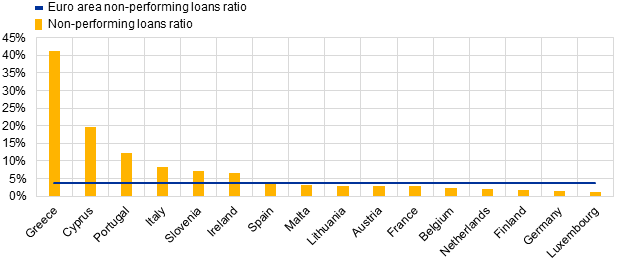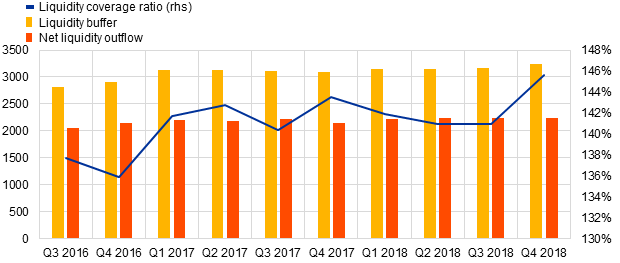- 11 April 2019
- Press release
ECB publishes supervisory banking statistics for the fourth quarter of 2018
- Capital ratios for significant institutions increase slightly in the fourth quarter of 2018, with total capital ratio at 17.95% (up from 17.83% in the third quarter).
- NPL ratio falls to 3.80%, lowest level since time series first published in 2015.
- Liquidity coverage ratio increases to 145.61%.
Capital adequacy
The capital ratios for the aggregated group of significant institutions, i.e. the banks supervised by the ECB, increased slightly in the fourth quarter of 2018 compared with the previous quarter. The Common Equity Tier 1 (CET1) ratio stood at 14.34%, the Tier 1 ratio at 15.54% and the total capital ratio at 17.95%. Average CET1 capital ratios at participating Member State level range from 11.93% in Spain to 25.48% in Luxembourg.
Chart 1
Total capital ratio and its components by reference period
(EUR billions, percentages)

Source: ECB.
Chart 2
Capital ratios by country
(Percentages)

Source: ECB.
Note: Data for some countries are not displayed either for confidentiality reasons or because there are no significant institutions at the highest level of consolidation.
Asset quality
The non-performing loans ratio (NPL ratio) fell further to 3.80% in the fourth quarter of 2018, which was the lowest level since supervisory banking statistics were first published in the second quarter of 2015. Luxembourg has the lowest average ratio, at 1.07%, while Greece has the highest, at 41.24%.
Chart 3
Non-performing loans by reference period
(EUR billions, percentages)

Source: ECB.
Chart 4
Non-performing loans ratio by country
(Percentages)

Source: ECB.
Note: Data for some countries are not displayed either for confidentiality reasons or because there are no significant institutions at the highest level of consolidation.
Liquidity
The liquidity coverage ratio increased to 145.61% in the fourth quarter of 2018, from 140.92% in the previous quarter. The average values range from 48.11% in Greece[1] to 392.72% in Slovenia.
Chart 5
Liquidity coverage ratio by reference period
(EUR billions, percentages)

Source: ECB.
Chart 6
Liquidity coverage ratio by country
(Percentages)

Source: ECB.
Note: Data for some countries are not displayed either for confidentiality reasons or because there are no significant institutions at the highest level of consolidation.
Factors affecting changes
Supervisory banking statistics are calculated by aggregating data reported by banks that report COREP (capital adequacy information) and FINREP (financial information) at that point in time. Changes in the amounts shown from one quarter to another can be influenced by the following factors:
- changes in the sample of reporting institutions;
- mergers and acquisitions;
- reclassifications (e.g. portfolio shifts where certain assets are reclassified from a particular accounting portfolio to another).
For media queries, please contact Stefan Ruhkamp, tel.: +49 69 1344 5057.
Notes
- The complete set of Supervisory banking statistics with additional quantitative risk indicators is available on the ECB’s banking supervision website.
- The figures for Greek banks are affected by external factors that temporarily hinder the use of the liquidity coverage ratio as an appropriate liquidity risk indicator.


